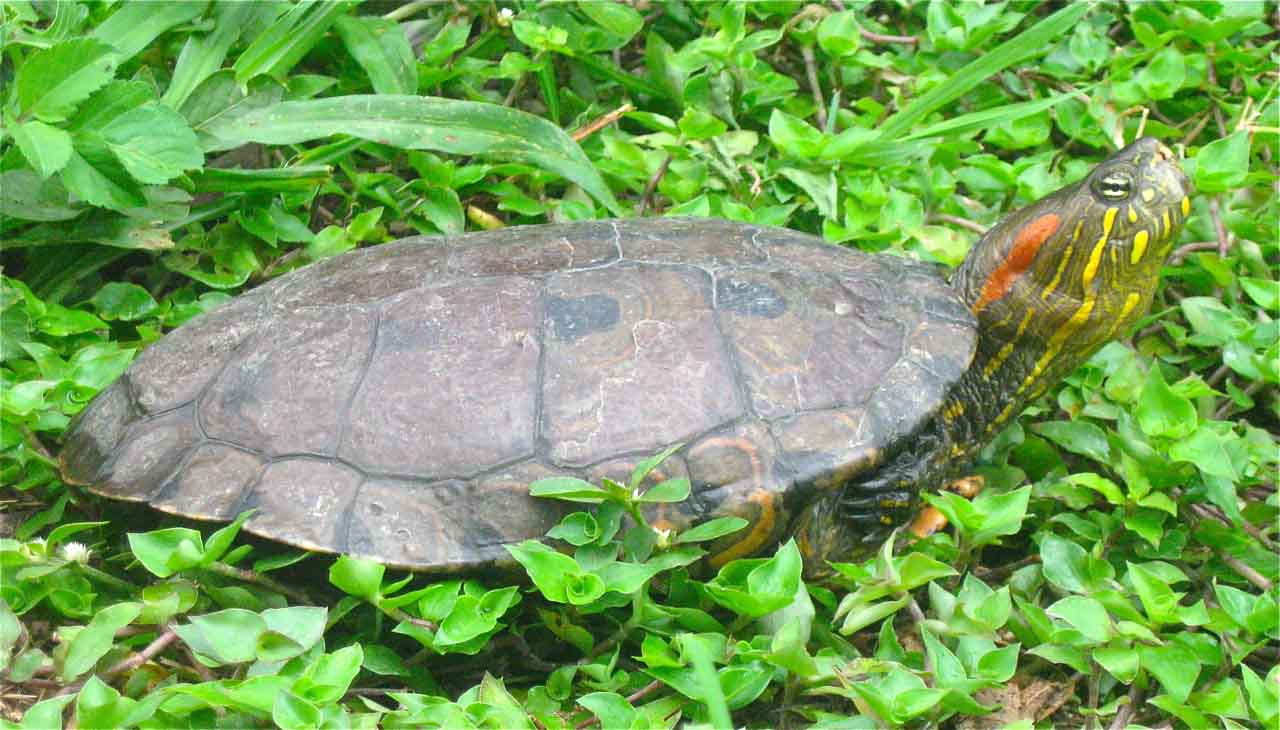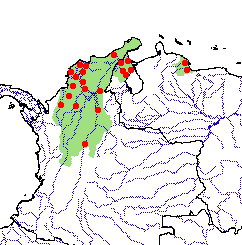Trachemys callirostris, 042
Trachemys callirostris (Gray 1856) –
Colombian Slider, Jicotea, Hicotea, Galapago, Morrocoy de Agua
Brian C. Bock1, Vivian P. Páez1, and Juan M. Daza1
1Instituto de Biología, Universidad de Antioquia, Medellín, Colombia
[[email protected]; [email protected]; [email protected]]
Summary. – The Colombian slider, Trachemys callirostris (Family Emydidae), is a moderate-sized turtle (carapace length to 33 cm) endemic to northern South America, with two recognized subspecies: T. c. callirostris in northern Colombia and northwest Venezuela, and T. c. chichiriviche further east along the Venezuelan coast. The two subspecies are distinguished by various aspects of their coloration and the structure of the second neural bone. There also may be differences in adult sizes, with T. c. callirostris being atypically small for a tropical slider turtle, but this may reflect the intense hunting pressures nesting females of this subspecies experience in most areas of its distribution. Trachemys callirostris is sexually dimorphic, with females being larger. While different populations may differ in mean body size, morphometric and genetic studies have provided no evidence for significant intra-specific variation besides the morphological differences between the two subspecies. These turtles are habitat generalists, omnivores, and bask frequently, but little else concerning their demography or non-breeding ecology is known. Nesting occurs during the dry season (December–May) and eggs are usually buried under low vegetation in moist soil near the shoreline. Clutch size depends on female size, and varies from 1–23 eggs. Predation on eggs and egg incubation failure is common. A study of incubation temperatures in natural nests found that with a mean incubation temperature of 31.7°C, all neonates produced were females, implying the species has temperature-dependent sex determination. Adults and nests are exploited throughout the range of the species, and despite protection by national legislation and the existence of several protected areas within the range of the species, current levels of exploitation probably are not sustainable. Enforcement of existing legislation and demographic monitoring are needed.
Distribution. – Colombia, Venezuela. Distributed in the Magdalena and Sinú river drainages in northern Colombia, around Lake Maracaibo in northwest Venezuela, and east along the Venezuelan coast in the states of Falcón and Carabobo.
Synonymy. – Emys callirostris Gray 1856, Callichelys callirostris, Pseudemys callirostris, Chrysemys ornata callirostris, Pseudemys scripta callirostris, Pseudemys ornata callirostris, Chrysemys callirostris, Chrysemys scripta callirostris, Trachemys scripta callirostris, Trachemys callirostris, Trachemys ornata callirostris, Trachemys dorbigni callirostris, Trachemys callirostris callirostris.
Subspecies. – Two currently recognized: Trachemys callirostris callirostris (Colombian Slider) and Trachemys callirostris chichiriviche (Venezuelan Slider) (synonymy: Pseudemys scripta chichiriviche Pritchard and Trebbau 1984, Trachemys scripta chichiriviche, Trachemys ornata chichiriviche.
Status. – IUCN 2009 Red List: Near Threatened (LR/nt; as Trachemys scripta, sensu lato) (assessed 1996, needs updating); CITES: Not Listed; Colombia Red Book: Near Threatened.
Citation:
Bock, B.C., Páez, V.P., and Daza, J.M. 2010. Trachemys callirostris (Gray 1856) – Colombian slider, jicotea, hicotea, galapago, morrocoy de agua. In: Rhodin, A.G.J., Pritchard, P.C.H., van Dijk, P.P., Saumure, R.A., Buhlmann, K.A., Iverson, J.B., and Mittermeier, R.A. (Eds.). Conservation Biology of Freshwater Turtles and Tortoises: A Compilation Project of the IUCN/SSC Tortoise and Freshwater Turtle Specialist Group. Chelonian Research Monographs No. 5, pp. 042.1–042.9, doi:10.3854/crm.5.042.callirostris.v1.2010, //iucn-tftsg.org/cbftt/.
(Adobe Acrobat 6.0 or later required)

Trachemys callirostris callirostris, adult female from Colombia.
Photo by Vivian P. Páez.
Distribution:

Distribution of Trachemys callirostris in Colombia and Venezuela in northwestern South America. Red points = museum and literature occurrence records based on Iverson (1992) plus more recent and authors’ data; green shading = projected distribution based on GIS-defined hydrologic unit compartments (HUCs) constructed around verified localities and then adding HUCs that connect known point localities in the same watershed or physiographic region, and similar habitats and elevations as verified HUCs (Buhlmann et al. 2009), and adjusted based on authors’ data. The larger disjunct range in Colombia and western Venezuela is T. c. callirostris, the smaller disjunct range in central coastal Venezuela is T. c. chichiriviche.








